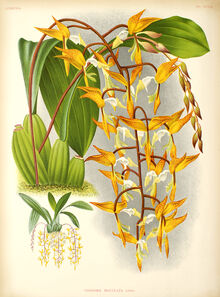| Gongora | ||||||||||||||||
|---|---|---|---|---|---|---|---|---|---|---|---|---|---|---|---|---|
|
| ||||||||||||||||
| ||||||||||||||||
Gongora (Ruiz and Pavon 1794, abbreviation Gga.) is a member of the Orchid family (Orchidaceae).
Distribution[]
It consists of 65 species known from Central America, Trinidad, and tropical South America. Most are found in Colombia. They grow in wide geographical range from wet forests at sea level to mountainous regions in the Andes, as high as 1,800 m.
Description[]
Gongora was one of the first orchids described by a western man. Several new Gongora orchids have been discovered in the last ten years, while many others have been assigned under another specific name. Yet there is still some confusion. Many species lack the right description. Some species, such as Gongora portentosa and Gongora superflua, are very rare. DNA fingerprinting will in time contribute to an exact taxonomy of this genus.
All species in this genus are epiphytes with a sympodial growth. The white aerial roots are very thin, growing in a dense pack. Some roots even grow upright instead of hanging down. This specialisation helps in forming the ball of aerial roots. Many are found in association with ant nests.
The conical pseudobulbs are ridged and are about 8 cm long. In some species, such as Gongora similis, the pseudobulb can produce up to six inflorescences in succession. Two alternate leaves originate from the end of each pseudobulb. The leaves are rather leathery and heavily veined, growing to a length of about 30 cm.
The racemose inflorescence grows from the base of the pseudobulbs. The stem first grows upright, but bends early in development and becomes pendulous. The numerous flowers hang upside down, with the lip upwards. The almost circularly bent pedicels are characteristic of this genus. There are two lateral sepals and one dorsal sepal. The blooms of several species are waxy. The flowers of many species have distinctive fragrances. Some smell like unburned candle wax, others like nutmeg, cardamom, or cinnamon. The pollinia are superposed on a stipe (a cellular pollinium stalk), which is held by a viscid disc.
The genus is closely related to Cirrhaea. For other relatives see also Stanhopeinae & Coeliopsidinae.
Culture[]
Plants are usually grown in wooden baskets in partial shade. Use a well drain potting media such as medium fir bark with perlite, tree fern fibers, or sphagnum moss. Keep area humid and grow in intermediate temperatures. Keep mix moist but not dry.
Naming[]
The name comes from Antonio Caballero y Gongora, a viceroy of New Granada (Colombia and Ecuador) and the governor of Peru during the Ruiz and Pavon botanical expedition.
Synonyms[]
- Acropera Lindl., Gen. Sp. Orchid. Pl.: 172 (1833).
Taxonomy[]
According to Rod Rice in Infragen. Rev. Gen. Gongora (2002, 2003) the genus Gongora can be classified into subgenera and sections as follows:
Subgenus Gongora
- Section Aceras with four species
- Section Gongora with about 30-33 species [G. atropurpurea, G. catilligera, G. latisepala, G. odoratissima, G. rufescens]
- Section Gratulabunda with four species
- Section Grossa with five species
- Section Truncata with nine species [G. charontis, G. dressleri, G. longipes, G. tracyana]
Subgenus Portentosa
- one section with at least five species [G. escobariana, G. garayana, G. portentosa, G. sanderiana]
Subgenus Acropera
- Section Acropera with one species
- Section Armeniaca with two species and one to two subspecies
- Section Cassidea with four species [G. amparoana, G. cassidea, G. galeata, G. tridentata]
Species[]
The representative species is Gongora quinquenervis.
|
References[]
| This page uses Creative Commons Licensed content from Wikipedia (view authors). | 
|
- Jenny, Rudolf 1993. Monograph of the genus Gongora Ruiz & Pavón
- W. Mark Whitten, Norris H. Williams and Mark W. Chase Subtribal and generic relationships of Maxillarieae (Orchidaceae) with emphasis on Stanhopeinae: combined molecular evidence, American Journal of Botany. 2000;87:1842-1856
- International Plant Names Index (IPNI)
